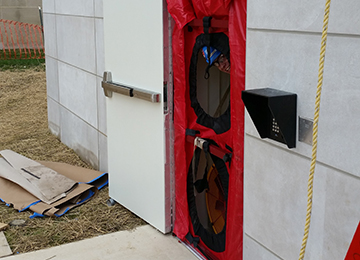Whole building air leakage testing is a quantitative test method that measures the air infiltration of a building after it has has been completely enclosed and finishes have been installed. It’s commonly known as blower door testing, because the fans are often placed in an open door frame. It’s also referred to as air barrier testing; most likely because the testing is often called for under the “07” section of the U.S. Army Corps of Engineers (USACE) specifications, under “Air Barrier.” The fans used for this testing are calibrated to measure air flow.
Air leakage testing is typically required if a project has USACE or similar specifications (such as NAVFAC, NASA, and AFCEC). While this testing isn’t inexpensive, a savvy commercial building owner may still require it up front to act as an incentive for the General Contractor to provide an air tight building. In addition to commercial building applications, institutional owners, such as universities and hospitals, may also have an interest in this type of testing. There is a correlation between a building that has a low air infiltration and lower operational costs. Especially in a larger facility, the cost of the test can be offset by money saved over the long term.
The fans may also be used in qualitative testing to diagnose conditions in both new and existing buildings. Fans can also be used to visually identify air leakage sites using tracer gas. Another qualitative testing method includes locating discontinuities in building insulation using infrared imaging.
For more information about air leakage testing, contact ECS Facilities Project Manager Andrew Fix.

